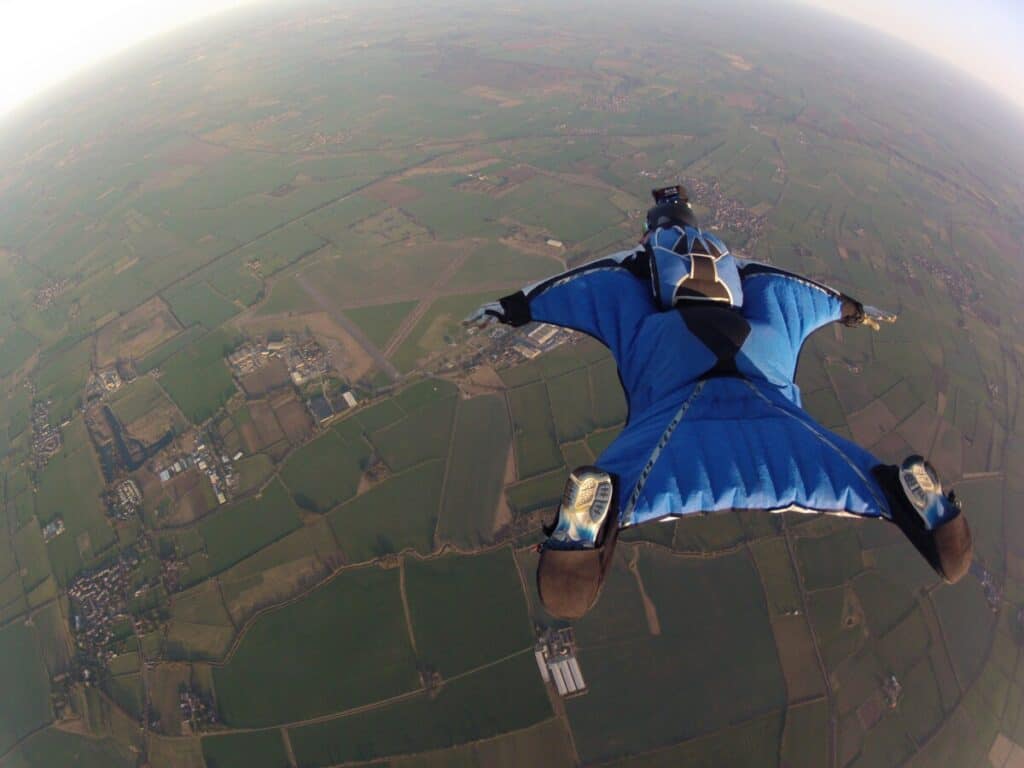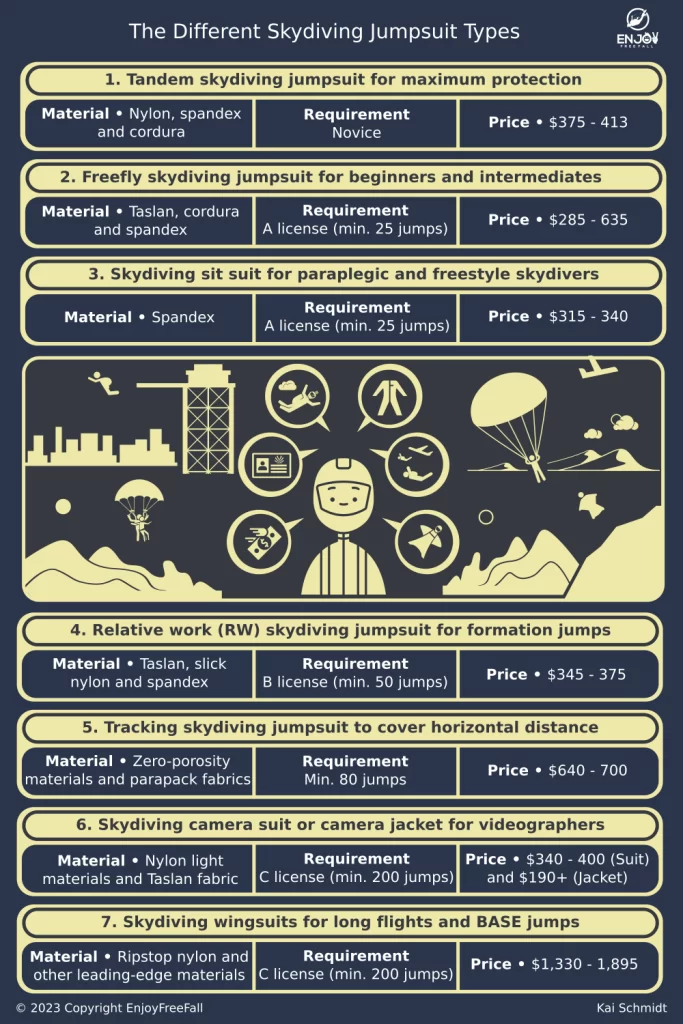
The excitement before a skydive starts when you arrive at the drop zone and put the jumpsuit on. You like the jumpsuit because it keeps you warm and helps you enjoy the free fall to the fullest. But have you ever wondered what the jumpsuit is made of?
Skydiving jumpsuits are made of specialized nylon, polyester, or polycotton main fabrics. Many manufacturers use their own patented fabrics which are composed of the three fabrics and differ in their blending composition, weaving procedure, and impregnation. More important than the material itself is the type and design of the jumpsuit.
The material of a skydiving jumpsuit does not only affect the performance but also the conformability and duration of the jumpsuit. However, the materials that the different jumpsuit manufacturers use are similar in quality, so it is more important to pay attention to the type of jumpsuit. Nonetheless, I have summarized a few nuances between the material below.
The Materials Of Skydiving Jumpsuits And How They Affect Your Jump
In the quest to deliver the best quality jumpsuit, manufacturers try to optimize their jumpsuits for the following criteria: flexibility, protection, durability, and comfort.
Flexibility Of The Jumpsuit Material
One factor that manufacturers try to optimize is the flexibility of the jumpsuits. Jumpsuits that use flexible material are normally very slim and tight to your body. They feel like a second skin and you do not feel them as much when moving around. Due to this, I sometimes compare them to wetsuits.
Because slim jumpsuits are so tight to your body they have less air resistance. As a result, you accelerate faster and can reach a higher speed. High-performance jumpers often use this kind of jumpsuit because they want to reach the fastest speed possible.
However, if you are a beginner, it is probably better to use a stiffer jumpsuit that is not too tight to your body. This will make the jumpsuit baggier and accelerate its size. As a result, your surface increases and so does your air resistance. This air resistance will slow you down and will make it easier to control your flight and to move around in the air.
Have you ever wondered how skydivers maneuver their bodies during freefall and safely navigate back to the ground? While it may look effortless, skydiving requires precise control and technique to achieve the desired outcomes. In this blog post, I delve into the different maneuvers skydivers use to control their movements and speed during freefall.
If you use a too flexible jumpsuit too fast, it can slow your learning process significantly. It’s best to start with a stiffer jumpsuit and then move to the tight one once you are ready!
Examples of flexible materials include Lycra, Spandex, Diamant Elastic, Supplex
Duration And Protection Of The Jumpsuit Material
Another factor that needs to be considered is the duration of the material. No one wants to buy a jumpsuit that only lasts for two years. A good jumpsuit should last at least 800 jumps i.e. approximately 10 years if you do skydiving as a regular hobby. Tunnel time (indoor wind tunnels are often used for skydiving training) can drastically reduce the durability of jumpsuits because you frequently hit the wall.
For example, jumpsuits that are made of Teflon or Ballistic Nylon are often more durable because their fabrics are much stronger than their flexible counterparts.
At the same time, these stronger fabrics help to protect the jumper against line burns and snags which is useful if you are a beginner. Ballistic nylon, for example, was one of the fabrics that were used for airmen jackets to protect its wearer against flying debris and artillery-shell impacts during World War II.
It is also advisable to use a more protective jumpsuit during a formation stunt because it usually has a better grip and protects you in case of any collisions.
Examples of durable and protective materials: Teflon, Ballistic Nylon, Cordura (this one is commonly used for the legs and knees)
Comfort Of The Jumpsuit Material
The last category of jumpsuit fabrics is wearing comfort. As you can imagine, the very protective material is very heavy and stiff, which results in low wearing comfort. Flexible material might be more comfortable to wear, however, it is often not breathable so you tend to sweat beneath it and it starts stinking faster.
As a result, the main and inner part of the jumpsuits are often composed of comfortable material such as Taslan or Taffeta. Besides being breathable, the material is often known to dry quickly.
Examples of comfortable materials – Nylon, Taslan, Taffeta, Supplex
Different Materials Are Used At Different Parts of The Skydiving Jumpsuit
The development of jumpsuit fabrics and design accelerates at a fast speed and gets better and better. Skydiving jumpsuits are usually not composed of just one fabric but different fabrics at different places. In this way, manufacturers can combine the best qualities of the fabrics in one jumpsuit.
For example, depending on the design of the jumpsuit, certain places will be reinforced by Cordura. Cordura is a very strong material that is often placed at the knees, legs or ass to protect people during the landing. It can also be used to reinforce arm areas in case the jumpsuit is designed for formation stunts. Cordura is ideal for formation jumpsuits because it provides a strong grip that allows other skydivers to hold you during the free fall.
Did you know that skydiving increases mental resilience and teaches people how to perform under pressure? If you want to learn more about it, check out my article about the 9 incredible benefits of starting skydiving as a hobby.
The extremely stretchable and flexible fabrics are usually used in areas where the skydiver requires strong mobility such as under the arms and between the legs. In this way, the skydiver can move around fast and without too much resistance.
If you use wind tunnel jumpsuits the knees will also be made of flexible material such as Spandex because people want to maneuver quickly in the tunnel and do not need protection.
The comfortable and lightweight material is often used at the back of the jumpsuit where it is not exposed to strong wind resistance. Depending on the design of the suit, lightweight materials such as Taffeta and Taslan can also be used in the front, which is often the case for faster jumpsuits (as the fabric breathes more, the wind goes through it more easily resulting in a higher speed):
As I said, the quality of the material is usually good across the brands and you will not make a mistake when choosing either of them. It is more important to decide on the right type of jumpsuit which depends on the type of jump that you will perform (then the right material is usually placed at the right spots).
As this topic goes beyond the scope of this post, I will create a new post that summarizes the different types of jumpsuits and gives guidance on how to select the best one.
Jumpsuits For Tandem Jumps And Skydive Beginners
When you are new to skydiving or just thinking about doing your first tandem jump, you will probably get a jumpsuit from the skydiving company. While you will have to pay for the equipment, once you have received your certificate and jump without an instructor, equipment such as the jumpsuit is almost always included in the price for tandem jumps and skydiving courses.
If you are going to perform your first skydive and are unsure what to wear, check out this article about the five things to wear and not to wear.
Tandem Student and Beginner Skydiving Jumpsuits
These jumpsuits are often designed to allow for the greatest jumping comfort while still protecting the student during the parachute deployment and the landing.
If you are performing a tandem jump soon, make sure that you check out my skydiving 101: everything you need to know about your tandem landing. It explains in detail what you as a tandem student can do to ensure a safe landing!
For example, the main part including the front is often made of Nylon which is comfortable for the student and can be washed more easily as well. The back, arms and legs are composed of a flexible material such as Spandex to allow the student some mobility (e.g. the student should be able to use his arms to steer the canopy) and the knees and buttocks are often made from Cordura. This makes the suit more durable and protects the students.
The difference between a tandem and skydiving solo jumpsuit is that the latter has legs and arm grippers such that the instructor can hold onto the student and help him stabilize during freefall.
Have you ever wondered how tandem skydiving feels different from solo skydiving? To learn more about the striking differences, check out my article about the 13 differences between tandem and solo skydiving.
Instructor Tandem Jumpsuits
While I have met many tandem instructors that jump even without a jumpsuit, it can really be beneficial to the jump and the jumping comfort for the instructor.
In comparison to other jumpsuits, the front legs, front arms, and butt are often made entirely with Cordura. Tandem suits often also have padded shoulders that reduce the weight strain when deploying a parachute. In addition, the suits often have more flexibility around the arms and the crotch to give the instructor the ability to counterbalance any panic movements of the students.
Specialized Jumpsuits Like Wingsuits and Pressure Suits
There also exists a wide range of specialized skydiving suits that are only designed for one purpose and therefore are made from special material to fulfill this purpose.
The pressure suit that Felix Baumgartner used when he jumped from 128,100ft (24 miles; 39km) was specifically designed to withstand extreme conditions and to break through the sound barrier (while most parts were comprised of Urethane-Coated Nylon and Neoprene-Coated Nylon, it also used some skydiving jumpsuit fabrics for the inner parts such as Teflon and Kevlar).
Another and more common example of specialized suits are wingsuits. While the main part of the wingsuit is very similar in its design and material to normal skydiving suits, the wings are usually made of ripstop nylon and reinforced by stronger material at the leading edge (the front of the wings).
When you have further questions about skydiving jumpsuit materials feel free to reach out to me!
If you are not sure what skydiving jumpsuit you should get, check this beginner’s guide to jumpsuits.
Enjoy your freefall!





